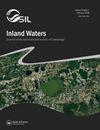沉积物和水柱的磷化学在不同的集水区地质的河流基流
IF 2.3
3区 环境科学与生态学
Q1 LIMNOLOGY
引用次数: 0
摘要
溪流可以减少磷的输入,从而抑制生态系统富营养化的可能性。这种P衰减来自许多过程,但人们对其了解甚少,特别是涉及到的地球化学机制。我们研究了P的衰减形式:(1)水柱中矿物(共)沉淀的潜力和(2)底栖沉积物对P的吸收。我们假设这两种机制因流域地质而异,P的吸附取决于沉积物活性铁(Fe)。我们对31条基流进行了采样,涵盖了磷输入(通过土地利用)、水文特征和集水区地质的梯度。测量了水柱的地球化学平衡,分析了底栖沉积物的吸附特性和P、Fe组分。含磷矿物和方解石-磷酸盐共沉淀均未形成。然而,在水柱和沉积物孔隙水之间的低渗交换可能足够的河流中,河流中溶解的活性磷(DRP)与稳定沉积物P(水溶性和容易还原的Fe-P)相关。由于这种不稳定的磷与结晶性差的铁氧化物有关,这决定了磷的吸附能力,我们观察到更多的吸附沉积物与DRP浓度呈正相关。研究结果表明,这些河流在基流处的DRP衰减部分取决于生物地球化学铁和磷循环的组合以及与潜流带的水文交换。这样的组合在流域内可能会随时空而变化,如果要很好地管理基流中的磷浓度和富营养化风险,就必须将其与磷和沉积物的输入一并考虑。本文章由计算机程序翻译,如有差异,请以英文原文为准。
Sediment and water-column phosphorus chemistry in streams at baseflow across varying catchment geologies
ABSTRACT Streams can attenuate inputs of phosphorus (P) and therefore dampen the likelihood of ecosystem eutrophication. This P attenuation derives from many processes and remains poorly understood, particularly in reference to the geochemical mechanisms involved. We studied P attenuation in the form of (1) potential for mineral (co-)precipitation from the water column and (2) P sorption with benthic sediments. We hypothesized that both mechanisms vary with catchment geology and that P sorption depends on sediment reactive iron (Fe). We sampled 31 streams at baseflow, covering a gradient of P inputs (via land use), hydrological characteristics, and catchment geologies. Geochemical equilibria in the water column were measured and benthic sediments were analyzed for sorption properties and P and Fe fractions. Neither P-containing minerals nor calcite-phosphate co-precipitation had the potential to form. However, in-stream dissolved reactive P (DRP) correlated with labile sediment P (water soluble and easily reduced Fe-P) for streams where hyporheic exchange between the water column and sediment porewaters was likely sufficient. Because this labile P was associated with poorly crystalline Fe oxides, which determined P sorption capacity, we observed that more sorptive sediments were positively related to DRP concentrations. Our results suggest that DRP attenuation in these streams at baseflow depends in part on the combination of biogeochemical Fe and P cycles and the hydrological exchange with the hyporheic zone. Such combinations will likely vary spatiotemporally within a catchment and must be considered alongside inputs of P and sediment if the P concentrations at baseflow, and eutrophication risk, are to be well managed.
求助全文
通过发布文献求助,成功后即可免费获取论文全文。
去求助
来源期刊

Inland Waters
LIMNOLOGY-MARINE & FRESHWATER BIOLOGY
CiteScore
6.10
自引率
9.70%
发文量
34
审稿时长
>12 weeks
期刊介绍:
Inland Waters is the peer-reviewed, scholarly outlet for original papers that advance science within the framework of the International Society of Limnology (SIL). The journal promotes understanding of inland aquatic ecosystems and their management. Subject matter parallels the content of SIL Congresses, and submissions based on presentations are encouraged.
All aspects of physical, chemical, and biological limnology are appropriate, as are papers on applied and regional limnology. The journal also aims to publish articles resulting from plenary lectures presented at SIL Congresses and occasional synthesis articles, as well as issues dedicated to a particular theme, specific water body, or aquatic ecosystem in a geographical area. Publication in the journal is not restricted to SIL members.
 求助内容:
求助内容: 应助结果提醒方式:
应助结果提醒方式:


